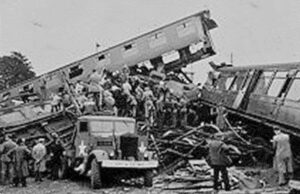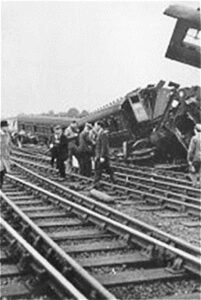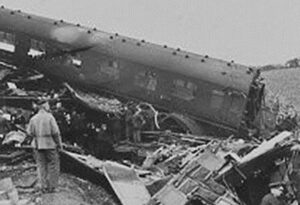 Trainwrecks can obviously happen at any time, but I think the worst time would be in the middle of the night, when the people onboard…other than the crew…are sleeping, or at the very least, dozing. There is nothing worse than being awakened to impending disaster. On September 30, 1945, a train was on its way from Perth to London Euston. The train was the 15-coach overnight Perth to London Euston express hauled by LMS Royal Scot Class 4-6-0 No 6157 The Royal Artilleryman. Part of the journey was to include a diversion, due to engineering work being done on the Watford tunnel. The train was scheduled to switch from the fast to the slow lines at Bourne End, near Hemel Hempstead. For reason unknown, the engineer failed to slow the train down in response to cautionary signals on the approach to the diversion. As a result, the train entered a 15-mile-per-hour turnout at nearly 60 miles per hour.
Trainwrecks can obviously happen at any time, but I think the worst time would be in the middle of the night, when the people onboard…other than the crew…are sleeping, or at the very least, dozing. There is nothing worse than being awakened to impending disaster. On September 30, 1945, a train was on its way from Perth to London Euston. The train was the 15-coach overnight Perth to London Euston express hauled by LMS Royal Scot Class 4-6-0 No 6157 The Royal Artilleryman. Part of the journey was to include a diversion, due to engineering work being done on the Watford tunnel. The train was scheduled to switch from the fast to the slow lines at Bourne End, near Hemel Hempstead. For reason unknown, the engineer failed to slow the train down in response to cautionary signals on the approach to the diversion. As a result, the train entered a 15-mile-per-hour turnout at nearly 60 miles per hour.
They were going far too fast, and the train couldn’t maintain its position on the tracks. The engine and the first six cars overturned and fell down an embankment into a field. When the derailment was over, only the last  three cars remained on the rails, 43 people were dead, and 65 people were injured. The investigation determined that the cause was driver error, possibly compounded by ambiguous signaling regulations. The fact that the engineer was very experienced with a reputation for being conscientious and had read the notice about the diversion before leaving Crewe, makes the accident that much more odd. It is thought that he may not have appreciated its significance of the diversion. He had worked 26 days consecutively due to staff shortages following the war, so it was possible that he had either momentarily dozed off or that fatigue caused him to momentarily go into “autopilot” mode. Unfortunately, this particular line had not yet been fitted with the Automatic Warning System, which probably could have prevented the accident.
three cars remained on the rails, 43 people were dead, and 65 people were injured. The investigation determined that the cause was driver error, possibly compounded by ambiguous signaling regulations. The fact that the engineer was very experienced with a reputation for being conscientious and had read the notice about the diversion before leaving Crewe, makes the accident that much more odd. It is thought that he may not have appreciated its significance of the diversion. He had worked 26 days consecutively due to staff shortages following the war, so it was possible that he had either momentarily dozed off or that fatigue caused him to momentarily go into “autopilot” mode. Unfortunately, this particular line had not yet been fitted with the Automatic Warning System, which probably could have prevented the accident.
As a train comes up to turns or track changes, the railroad provides advance warning of the turnout by “a color light distant signal showing double yellow, an outer home signal showing green, and two ‘splitting’ semaphore inner homes side by side showing which route was set. The double yellow aspect could have an important extra meaning under Rule 35b(ii), “In some cases, color light signals will exhibit two yellow lights. This indication means – Pass next signal at restricted speed, and if applicable to a junction may denote that the points are set for a diverging route over which the speed restriction shown in the appendix applies.” Because this arrangement is ambiguous, the inspector pointed out that it evidently did not alert the engineer to the  approaching low speed turnout. It was unclear why he failed to notice the diverging route indication of the splitting inner homes. It’s possible that the low sun shining directly in his face would have made observation tiring, but the signals were still clearly visible.
approaching low speed turnout. It was unclear why he failed to notice the diverging route indication of the splitting inner homes. It’s possible that the low sun shining directly in his face would have made observation tiring, but the signals were still clearly visible.
The accident was first reported by a pilot who had just taken off from Bovingdon Aerodrome. As he took off, he could see the accident, so he immediately notified the railway authorities via the Bovingdon Control tower. Airfield staff also helped significantly with assistance after the crash. With the death toll at 43, this became Britain’s joint seventh worst rail disaster in terms of death toll.


Leave a Reply